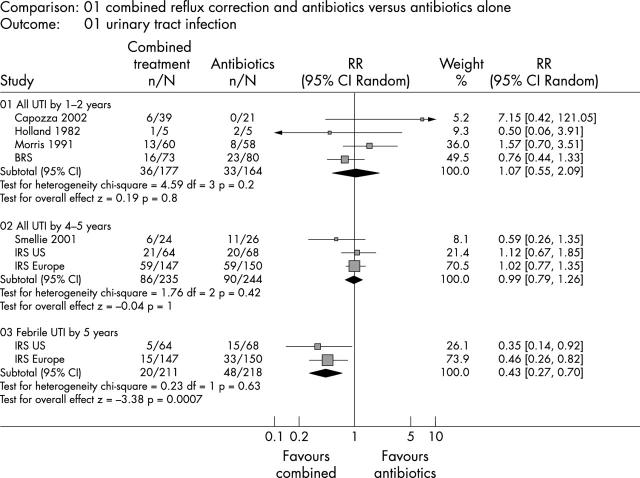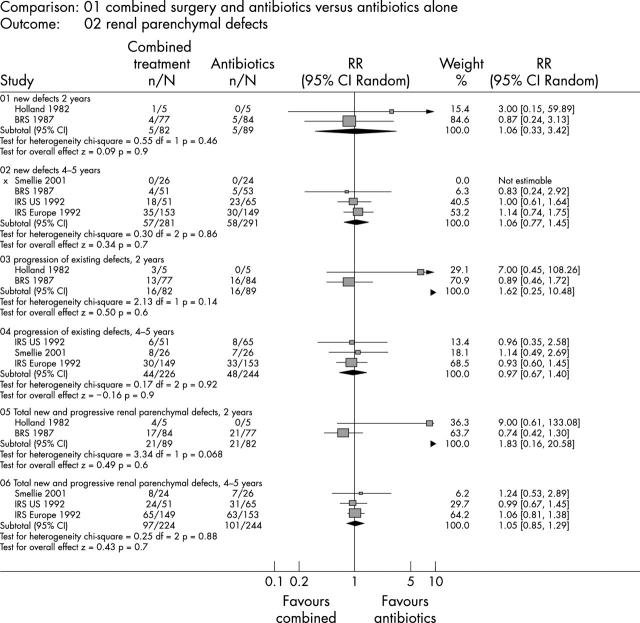Abstract
Aims: To evaluate the benefits and harms of treatments for vesicoureteric reflux in children.
Methods: Meta-analyses of randomised controlled trials using a random effects model. Main outcome measures were incidence of urinary tract infection (UTI), new or progressive renal damage, renal growth, hypertension, and glomerular filtration rate.
Results: Eight trials involving 859 evaluable children comparing long term antibiotics with surgical correction of reflux (VUR) and antibiotics (seven trials) and antibiotics compared with no treatment (one trial) were identified. Risk of UTI by 1–2 and 5 years was not significantly different between surgical and medical groups (relative risk (RR) by 2 years 1.07; 95% confidence interval (CI) 0.55 to 2.09, RR by 5 years 0.99; 95% CI 0.79 to 1.26). Combined treatment resulted in a 60% reduction in febrile UTI by 5 years (RR 0.43; 95% CI 0.27 to 0.70) but no concomitant significant reduction in risk of new or progressive renal damage at 5 years (RR 1.05; 95% CI 0.85 to 1.29). In one small study no significant differences in risk for UTI or renal damage were found between antibiotic prophylaxis and no treatment.
Conclusion: It is uncertain whether the identification and treatment of children with VUR confers clinically important benefit. The additional benefit of surgery over antibiotics alone is small at best. Assuming a UTI rate of 20% for children with VUR on antibiotics for five years, nine reimplantations would be required to prevent one febrile UTI, with no reduction in the number of children developing any UTI or renal damage.
Full Text
The Full Text of this article is available as a PDF (430.9 KB).
Figure 1 .
Meta-analyses of relative risk (random effects model) of urinary tract infections. Subtotals pertain to all urinary tract infections at 2 years post-entry (outcome 01), all urinary tract infections at 5 years post-entry (outcome 02), and symptomatic (febrile) urinary tract infections at 5 years post-entry (outcome 03). BRS, Birmingham Reflux Study; IRS Europe, European arm of the International Reflux Study; IRS US, United States arm of the International Reflux Study. Trials are shown ordered by study weights. No heterogeneity was shown using Cochran's Q statistic (χ2 analysis with degrees of freedom, df). The test statistics Z indicate that there were no significant differences between the combined treatment group and the antibiotic only group of patients with vesicoureteric reflux except for febrile urinary tract infection (outcome 03).
Figure 2 .
Meta-analyses of relative risk (random effects model) for the development of renal parenchymal abnormalities diagnosed by intravenous pyelogram. Subtotals pertain to new defects at 2 and 5 years (outcomes 01 and 03), progression of those previously identified at 2 and 5 years post-entry (outcomes 02 and 04), and all defects, both new and progressive, at both 2 and 5 years (outcomes 05 and 06). BRS, Birmingham Reflux Study; IRS Europe, European arm of the International Reflux Study; IRS US, United States arm of the International Reflux Study. Trials are shown ordered by study weights. No heterogeneity was shown using Cochran's Q statistic (χ2 analysis with degrees of freedom, df). The test statistics Z indicate that there were no significant differences between the combined treatment group and the antibiotic only group of patients with vesicoureteric reflux.
Selected References
These references are in PubMed. This may not be the complete list of references from this article.
- Belman A. B. A perspective on vesicoureteral reflux. Urol Clin North Am. 1995 Feb;22(1):139–150. [PubMed] [Google Scholar]
- Capozza Nicola, Caione Paolo. Dextranomer/hyaluronic acid copolymer implantation for vesico-ureteral reflux: a randomized comparison with antibiotic prophylaxis. J Pediatr. 2002 Feb;140(2):230–234. doi: 10.1067/mpd.2002.121380. [DOI] [PubMed] [Google Scholar]
- Duckett J. W., Walker R. D., Weiss R. Surgical results: International Reflux Study in Children--United States branch. J Urol. 1992 Nov;148(5 Pt 2):1674–1675. doi: 10.1016/s0022-5347(17)36999-9. [DOI] [PubMed] [Google Scholar]
- Elder J. S., Peters C. A., Arant B. S., Jr, Ewalt D. H., Hawtrey C. E., Hurwitz R. S., Parrott T. S., Snyder H. M., 3rd, Weiss R. A., Woolf S. H. Pediatric Vesicoureteral Reflux Guidelines Panel summary report on the management of primary vesicoureteral reflux in children. J Urol. 1997 May;157(5):1846–1851. [PubMed] [Google Scholar]
- Frankenschmidt A., Katzenwadel A., Zimmerhackl L. B., Sommerkamp H. Endoscopic treatment of reflux by subureteric collagen injection: critical review of 5 years' experience. J Endourol. 1997 Oct;11(5):343–348. doi: 10.1089/end.1997.11.343. [DOI] [PubMed] [Google Scholar]
- Frey P., Gudinchet F., Jenny P. GAX 65: new injectable cross-linked collagen for the endoscopic treatment of vesicoureteral reflux--a double-blind study evaluating its efficiency in children. J Urol. 1997 Sep;158(3 Pt 2):1210–1212. [PubMed] [Google Scholar]
- Goossens H., Sprenger M. J. Community acquired infections and bacterial resistance. BMJ. 1998 Sep 5;317(7159):654–657. doi: 10.1136/bmj.317.7159.654. [DOI] [PMC free article] [PubMed] [Google Scholar]
- Hellström A., Hanson E., Hansson S., Hjälmås K., Jodal U. Association between urinary symptoms at 7 years old and previous urinary tract infection. Arch Dis Child. 1991 Feb;66(2):232–234. doi: 10.1136/adc.66.2.232. [DOI] [PMC free article] [PubMed] [Google Scholar]
- Hjälmås K., Löhr G., Tamminen-Möbius T., Seppänen J., Olbing H., Wikström S. Surgical results in the International Reflux Study in Children (Europe). J Urol. 1992 Nov;148(5 Pt 2):1657–1661. doi: 10.1016/s0022-5347(17)36996-3. [DOI] [PubMed] [Google Scholar]
- Holland N. H., Kazee M., Duff D., McRoberts J. W. Antimicrobial prophylaxis in children with urinary tract infection and vesicoureteral reflux. Rev Infect Dis. 1982 Mar-Apr;4(2):467–474. doi: 10.1093/clinids/4.2.467. [DOI] [PubMed] [Google Scholar]
- Jodal U., Koskimies O., Hanson E., Löhr G., Olbing H., Smellie J., Tamminen-Möbius T. Infection pattern in children with vesicoureteral reflux randomly allocated to operation or long-term antibacterial prophylaxis. The International Reflux Study in Children. J Urol. 1992 Nov;148(5 Pt 2):1650–1652. doi: 10.1016/s0022-5347(17)36994-x. [DOI] [PubMed] [Google Scholar]
- Lau J., Ioannidis J. P., Schmid C. H. Quantitative synthesis in systematic reviews. Ann Intern Med. 1997 Nov 1;127(9):820–826. doi: 10.7326/0003-4819-127-9-199711010-00008. [DOI] [PubMed] [Google Scholar]
- Olbing H., Claësson I., Ebel K. D., Seppänen U., Smellie J. M., Tamminen-Möbius T., Wikstad I. Renal scars and parenchymal thinning in children with vesicoureteral reflux: a 5-year report of the International Reflux Study in Children (European branch). J Urol. 1992 Nov;148(5 Pt 2):1653–1656. doi: 10.1016/s0022-5347(17)36995-1. [DOI] [PubMed] [Google Scholar]
- Olbing H., Hirche H., Koskimies O., Lax H., Seppänen U., Smellie J. M., Tamminen-Möbius T., Wikstad I. Renal growth in children with severe vesicoureteral reflux: 10-year prospective study of medical and surgical treatment: the International Reflux Study in Children (European branch). Radiology. 2000 Sep;216(3):731–737. doi: 10.1148/radiology.216.3.r00au35731. [DOI] [PubMed] [Google Scholar]
- Olbing H. Vergleich von chirurgischer und nicht-chirurgischer Behandlung beim primären vesiko-uretero-renalen Reflux--Internationale Refluxstudie. Kinderarztl Prax. 1986 Sep;54(9):493–499. [PubMed] [Google Scholar]
- Oswald J., Riccabona M., Lusuardi L., Bartsch G., Radmayr C. Prospective comparison and 1-year follow-up of a single endoscopic subureteral polydimethylsiloxane versus dextranomer/hyaluronic acid copolymer injection for treatment of vesicoureteral reflux in children. Urology. 2002 Nov;60(5):894–898. doi: 10.1016/s0090-4295(02)01903-9. [DOI] [PubMed] [Google Scholar]
- Phillips D. A., Watson A. R., MacKinlay D. Distress and the micturating cystourethrogram: does preparation help? Acta Paediatr. 1998 Feb;87(2):175–179. doi: 10.1080/08035259850157624. [DOI] [PubMed] [Google Scholar]
- Piepsz A., Tamminen-Möbius T., Reiners C., Heikkilä J., Kivisaari A., Nilsson N. J., Sixt R., Risdon R. A., Smellie J. M., Söderborg B. Five-year study of medical or surgical treatment in children with severe vesico-ureteral reflux dimercaptosuccinic acid findings. International Reflux Study Group in Europe. Eur J Pediatr. 1998 Sep;157(9):753–758. doi: 10.1007/s004310050929. [DOI] [PubMed] [Google Scholar]
- Scholtmeijer R. J. Treatment of vesicoureteric reflux. Results of a prospective study. Br J Urol. 1993 Mar;71(3):346–349. doi: 10.1111/j.1464-410x.1993.tb15956.x. [DOI] [PubMed] [Google Scholar]
- Schulz K. F., Chalmers I., Hayes R. J., Altman D. G. Empirical evidence of bias. Dimensions of methodological quality associated with estimates of treatment effects in controlled trials. JAMA. 1995 Feb 1;273(5):408–412. doi: 10.1001/jama.273.5.408. [DOI] [PubMed] [Google Scholar]
- Smellie J. M., Barratt T. M., Chantler C., Gordon I., Prescod N. P., Ransley P. G., Woolf A. S. Medical versus surgical treatment in children with severe bilateral vesicoureteric reflux and bilateral nephropathy: a randomised trial. Lancet. 2001 Apr 28;357(9265):1329–1333. doi: 10.1016/S0140-6736(00)04520-7. [DOI] [PubMed] [Google Scholar]
- Smellie J. M., Poulton A., Prescod N. P. Retrospective study of children with renal scarring associated with reflux and urinary infection. BMJ. 1994 May 7;308(6938):1193–1196. doi: 10.1136/bmj.308.6938.1193. [DOI] [PMC free article] [PubMed] [Google Scholar]
- Smellie J. M., Tamminen-Möbius T., Olbing H., Claesson I., Wikstad I., Jodal U., Seppänen U. Five-year study of medical or surgical treatment in children with severe reflux: radiological renal findings. The International Reflux Study in Children. Pediatr Nephrol. 1992 May;6(3):223–230. doi: 10.1007/BF00878353. [DOI] [PubMed] [Google Scholar]
- Smellie J. M., Tamminen-Möbius T., Olbing H., Claesson I., Wikstad I., Jodal U., Seppänen U. Radiologische Nierenbefunde bei Kindern mit schwerem Reflux. Fünfjahresvergleichsstudie konservativer und chirurgischer Behandlung. Urologe A. 1993 Jan;32(1):22–29. [PubMed] [Google Scholar]
- Tamminen-Möbius T., Brunier E., Ebel K. D., Lebowitz R., Olbing H., Seppänen U., Sixt R. Cessation of vesicoureteral reflux for 5 years in infants and children allocated to medical treatment. The International Reflux Study in Children. J Urol. 1992 Nov;148(5 Pt 2):1662–1666. doi: 10.1016/s0022-5347(17)36997-5. [DOI] [PubMed] [Google Scholar]
- Weiss R., Duckett J., Spitzer A. Results of a randomized clinical trial of medical versus surgical management of infants and children with grades III and IV primary vesicoureteral reflux (United States). The International Reflux Study in Children. J Urol. 1992 Nov;148(5 Pt 2):1667–1673. doi: 10.1016/s0022-5347(17)36998-7. [DOI] [PubMed] [Google Scholar]
- Weiss R., Tamminen-Möbius T., Koskimies O., Olbing H., Smellie J. M., Hirche H., Lax-Gross H. Characteristics at entry of children with severe primary vesicoureteral reflux recruited for a multicenter, international therapeutic trial comparing medical and surgical management. The International Reflux Study in Children. J Urol. 1992 Nov;148(5 Pt 2):1644–1649. doi: 10.1016/s0022-5347(17)36993-8. [DOI] [PubMed] [Google Scholar]
- Wennerström M., Hansson S., Jodal U., Stokland E. Primary and acquired renal scarring in boys and girls with urinary tract infection. J Pediatr. 2000 Jan;136(1):30–34. doi: 10.1016/s0022-3476(00)90045-3. [DOI] [PubMed] [Google Scholar]




